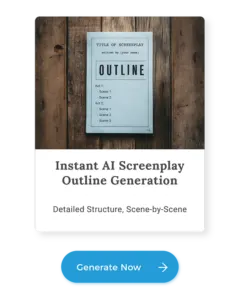Have you ever wondered how movies are produced? A well-structured screenplay is fundamental for successful movie production.
A screenplay is the backbone of any film, ensuring every scene and action flows seamlessly. Without a well-structured screenplay, a movie would lack direction and coherence, making it challenging to deliver a compelling story to the audience.
What is a Screenplay?
A screenplay is a written document that outlines the narrative, dialogue, and instructions for a film or television production. It serves as a blueprint for the actors, directors, and crew to create the final polished movie or TV show. Screenplays include character descriptions, scene settings, and specific actions, guiding the entire production process from concept to screen.
There is always a guide with connected sequences for every action or event in a movie. This guideline helps the actors and crew produce compelling and cohesive content for the audience. The ultimate goal for the actors and the film industry is to create a production that resonates with viewers and brings their roles to life convincingly.
How to Structure a Screenplay?
To structure a screenplay effectively, writers must follow an organized framework that outlines the narrative, characters, and key events. This framework typically includes a standard structure like the five-act structure or the three-act structure. By adhering to one of these structures, writers ensure that the screenplay has a coherent flow and keeps the audience engaged from beginning to end.
Step 1: Come Up With the Movie Title
Every screenplay needs a title that encapsulates the essence of the story. This title sets the tone and provides a first impression to anyone reading the screenplay. It is important to craft a compelling title that hints at the central theme and draws interest.
The title should be prominently displayed on the title page, which serves as the screenplay’s cover. The title page must be professional and well-organized, as it is the first thing industry professionals will see.
The title page should include the following elements:
The script title
Your name
Your contact details
Additionally, some directors or producers may request that you include the draft date on the title page. This can indicate the script’s recency or the version being reviewed.
Step 2: Identify the Location and Time of the Action
After finalizing the title page, determine where and when the action of your screenplay takes place. This information is crucial for setting the context and atmosphere of your story.
Knowing the locations and times of your scenes early in the writing process helps in planning and prevents potential issues during production. It also allows the production team to budget appropriately for locations, set designs, and logistical needs.
Include this information in your scene headings, which typically follow this format:
INT./EXT. [Location] – [Time of Day]
For example:
INT. COFFEE SHOP – MORNING
EXT. BEACH – SUNSET
By clearly stating the location and time, you provide a roadmap for the entire production team, ensuring a smooth transition from script to screen.
Step 3: Introduce the Characters
Once the title and scene settings are established, introduce the characters. This step is critical as it sets the stage for the actors and helps the audience understand who is involved in the story.
When introducing a character for the first time, write their name in all caps and provide a brief description of their role and personality. This helps actors and directors understand the character’s essence and motivations.
For example:
JANE SMITH
, a determined journalist in her early thirties, always on the hunt for the next big story.
Ensure that each character’s introduction is clear and evocative, giving the actors enough information to connect with their roles emotionally. This will help them bring the characters to life convincingly.
Using tools like Squibler, you can store detailed character descriptions and seamlessly integrate them into your narrative as you develop your screenplay.
Step 4: Create the Climax
The inciting incident is a pivotal moment in your screenplay that grabs the audience’s attention and propels the main character into the central conflict of the story. This incident should be unique and compelling, encouraging the reader or viewer to stay engaged with the narrative.
At this stage, the central character performs an action or experiences an event that changes the course of their life. This moment often leads to a shift in the environment or circumstances, compelling the character to leave their ordinary world behind and embark on a new journey.
For example, in the TV series “24” (2001), Jack Bauer’s life changes drastically when he learns that terrorists have abducted his family. This revelation forces him to focus on rescuing his wife and daughter, setting the stage for the rest of the series. This development marks the end of Act I, transitioning from the introduction to the main conflict.
Use Squibler to add more conflict, intensity, and drama to your screenplay with the help of AI. You can either expand an ongoing plot or just provide instructions from the start to the Smart Writer and it will handle the rest.
Step 5: Develop on the Screenplay Body
In this step, you will expand on the foundation laid in the introduction by delving into the main body of the screenplay, typically referred to as the second act. This is where the core of the drama unfolds, and the plot thickens.
At this stage, introduce subplots and emerging threats that challenge the protagonist. These elements reveal the true depth and capabilities of the hero. The protagonist often forms an inner circle of allies who assist in overcoming obstacles. However, new barriers and betrayals continually arise, maintaining tension and conflict.
The midpoint of the screenplay should present significant challenges that the protagonist must face to achieve their primary goal. This section is crucial for developing tension and pushing the hero to their limits, showcasing their true character.
During this part of the screenplay, the protagonist may feel cornered and overwhelmed by the challenges they encounter. This evokes strong emotional reactions and investment from the audience as they read. The goal is to make the reader root for the hero and become deeply engaged in their journey.
Ensure that your screenplay remains compelling by continuously introducing new conflicts and maintaining high stakes. This keeps the narrative dynamic and engaging, driving the story forward.
The audience at this point has a team supporting the hero’s side, while there could be others of the contrary opinion. However, the readers are all down to earth, praying that a miracle salvages the hero’s journey.
Step 6: Introduce “The Actual Disaster”
This section is where the actors feel they have lost; at least, that’s how the readers see it. It becomes so hard for the hero to get out of a particular problem. And it eventually seems that they have exhausted all their means.
The other accompanying actors of the play have all their hopes in their hero, who seems to have given up in the entire game. But that’s not usually the case.
At this point, the readers also feel they have lost all hope in the next moves. For instance, in the 24 series, there is a time when Jack Baure, the hero, goes to the Chinese prison to kill one of the Chinese on American soil.
After his arrest, we all feel that he’s not going to make it to the Chinese prison, considering that the Chinese needed to get American defense secrets.
Since Jack Baure is the hero who leads in arresting terrorists on US soil, everything goes wrong once he goes to the Chinese prison. But here comes the next step.
If you want to add more drama to the disaster, use Squibler to intensify the details. Just select the plot that you’re developing, and AI will work around the selected text to generate more details making it overall better.
Step 7: Present The Solution
As much as Jack was in life imprisonment in the Chinese government, the new president of the US rescues Jack to come and save the country from terrorism. And that’s how he’s back in the line.
The main character always has a leeway to come back to their senses and do what they do best. That’s why we call this the resolution stage.
This stage is for salvaging the situation and solving the problem once and for all. Finally, of course, the hero would have accomplished all their main goals and targets of the play.
And that takes us to finalize the screenplay and story structure. Then, finally, the remaining actors come together and maybe celebrate their win in a big way. Of course, others end in dilemmas and sad situations, but the end has to happen anyway.
What is the Three-Act Structure in a Screenplay?
The three-act structure is a classic framework that most writers use to organize their screenplays. It divides the story into three distinct parts:
Act I: The Setup/Introduction
This section introduces the characters, setting, and the central theme of the story. It establishes the world of the screenplay and ensures that the audience understands the roles of the main characters and the initial situation.
Act II: Conflict
In this part, the story’s main conflict develops and escalates. The characters face various challenges and obstacles, showcasing their abilities and struggles. This act is often the longest and is where the bulk of the action and drama occurs, keeping the audience engaged and invested in the characters’ journeys.
Act III: The Resolution
The final act brings the story to its conclusion. The main character faces the climax, where they confront the central conflict head-on. The resolution provides a solution to the problems introduced earlier, although this solution may sometimes be temporary or misleading, resulting in a false victory. Alternatively, some stories use a circular structure, ending where they began, highlighting the cyclical nature of the narrative.
What is the Five-Act Structure in a Screenplay?
The five-act structure is a more detailed framework often used in screenwriting to provide a deeper and more nuanced narrative. This structure divides the story into five parts, each serving a specific purpose in the overall narrative arc:
Act I: Exposition
The exposition sets the stage for the story, introducing the main characters, setting, and the central theme. It establishes the world of the screenplay and provides the audience with the necessary background information to understand the story’s context.
Act II: Rising Action
In this act, the main conflict begins to unfold. The protagonist faces initial challenges and obstacles, and the tension starts to build. This act is designed to develop the characters and deepen the audience’s understanding of their motivations and goals.
Act III: Climax
The climax is the turning point of the story. It is the moment of greatest tension and conflict, where the protagonist faces their biggest challenge. The outcome of this confrontation will significantly impact the direction of the story and the fate of the characters.
Act IV: Falling Action
After the climax, the story moves into the falling action, where the consequences of the climax play out. The protagonist and other characters deal with the aftermath of the central conflict, and the story begins to move towards resolution. This act often involves addressing secondary conflicts and tying up loose ends.
Act V: Resolution
The resolution brings the story to a close. The main conflicts are resolved, and the characters find a new sense of equilibrium. This act provides closure to the story, answering any remaining questions and leaving the audience with a sense of completion.
Another approach is the circular structure, where the story finishes right where it starts, emphasizing the circular aspect of the narrative. The screenplay for this type of story must be structured properly, considering the correlation between the start and end.
With AI, you can generate a custom outline tailored to the Five-Act Structure instantly. This can help you stay organized, ensure your story flows smoothly, and save valuable time in the writing process.

Other Screenplay Structures
In addition to the standard three-act structure and five-act structure, screenwriters can explore various other screenplay structures to create a compelling story. These structures provide different ways to present narratives, adding depth and complexity to the film script.
Multiple Timeline Structures
Using multiple timeline structures, such as the reverse chronological structure or the Rashomon structure, allows screenwriters to present events from different perspectives. This approach can add intrigue and keep the audience’s attention by revealing the story in pieces.
Circular Structure
The circular structure brings the story full circle, ending where it began. This technique can create a sense of completeness and symmetry in the narrative, emphasizing the journey of the main character and their development throughout the film.
Oneiric Structure
The oneiric structure blends reality and dream-like sequences, creating a surreal and immersive experience for the audience. This structure is ideal for stories that explore the subconscious or involve fantastical elements.
Self-Contained Story Structure
A self-contained story structure focuses on a single, standalone narrative without relying on sequels or prequels. This approach ensures that all plot points are resolved within the film, providing a satisfying conclusion for the audience.
Hero’s Journey
The hero’s journey is a classic structure with a narrative framework that follows the main character through stages of departure, initiation, and return. This structure highlights the protagonist’s transformation and growth, making it ideal for character-driven stories.
Non-Linear Films
Non-linear films present events out of chronological order, creating a narrative that jumps around in time and generating a puzzle for the audience to piece together. This approach can involve flashbacks, flash-forwards, or other disruptions to the sequential flow of the story.
Integrating Story Events and Beats
Effective screenplays carefully plan story events and beats to maintain pacing and tension. By mapping out key moments, such as the inciting incident, rising action, and final conflict, screenwriters can ensure that the narrative remains compelling from beginning to end.
Final Remarks
Crafting a screenplay is both an art and a science, requiring creativity, precision, and adherence to structural guidelines. By understanding and applying structures like the three-act or five-act framework, you can create a compelling and well-organized narrative that resonates with audiences.
Remember, the success of your screenplay hinges not just on your storytelling ability but also on your attention to detail and willingness to collaborate with directors and production teams. Each element, from the title page to the resolution, plays a vital role in bringing your vision to life.
As you embark on your screenwriting journey, stay dedicated, be open to feedback, and continually refine your craft. Your passion and hard work can lead to stories that entertain, inspire, and leave a lasting impact.
FAQs
Here are the most common questions that authors ask about structuring the screenplay:
How should I begin a screenplay?
Start your screenplay with a compelling opening scene that immediately draws the audience into the world of your story. This could involve presenting a unique situation, introducing a fascinating character, or posing an intriguing question.
What’s the importance of the three-act structure?
The basic three-act structure serves as a roadmap for storytelling. In the three-act structure screenplay setup, you establish the characters, setting, and main conflict. The conflict intensifies in Act II, leading to a climax, and Act III resolves the conflict and provides a satisfying conclusion.
This multiple-timeline structure helps maintain a balanced and well-paced narrative, ensuring that the audience remains invested from beginning to end.
How do I develop characters effectively?
Effective character development involves defining each character’s unique traits, motivations, and internal conflicts. Create characters with distinct personalities and relatable goals, allowing the audience to connect emotionally.
Show their growth or transformation throughout the story, making them dynamic and engaging. By giving characters depth and complexity, you enhance the overall richness of your screenplay.
How to build tension in a screenplay?
It’s all about strategic storytelling. Introduce conflicts that escalate gradually, raising the stakes for the characters. Use pacing to your advantage—alternating between moments of calm and intense action. Tension is often built in the second act of the screenplay structure, while Act I only revolves around creating the plot and understanding of the characters.
Create anticipation by leaving questions unanswered and building suspense. Tension keeps the audience invested and eager to see how the story unfolds. Such stories are essential to keep viewers engaged.



